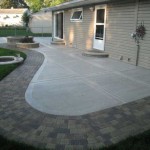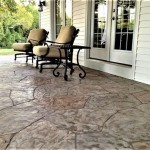Refinishing Metal Patio Table and Chairs: A Comprehensive Guide
Metal patio furniture, while durable and often aesthetically pleasing, is susceptible to rust, fading, and general wear and tear from exposure to the elements. Refinishing metal patio tables and chairs is a practical and cost-effective way to restore their appearance and prolong their lifespan. This process involves several key steps, from thorough preparation to the application of protective coatings, ensuring a revitalized and resilient outdoor furniture set.
The decision to refinish metal patio furniture is often driven by a combination of aesthetic and practical considerations. A worn-out furniture set can detract from the overall appearance of an outdoor space. Refinishing can dramatically improve the look, allowing for customization with new colors and finishes. Furthermore, addressing rust and corrosion early prevents further deterioration of the metal, potentially saving on replacement costs in the long run. Regular maintenance, including refinishing when necessary, is integral to maximizing the investment in outdoor furniture.
Key Point 1: Preparation is Paramount
Effective preparation is arguably the most crucial step in refinishing metal patio furniture. Failing to properly prepare the surface will compromise the adhesion of the new finish and result in premature chipping, peeling, and rust recurrence. The preparation phase encompasses cleaning, rust removal, and surface smoothing, each requiring specific tools and techniques.
Begin by thoroughly cleaning the furniture. This removes dirt, grime, mildew, and loose paint flakes that can interfere with the refinishing process. A solution of warm water and mild detergent is typically sufficient for initial cleaning. Use a scrub brush to agitate stubborn dirt and debris. Power washing can be used with caution, ensuring the pressure is not so high as to damage the existing finish or warp the metal. Allow the furniture to dry completely before proceeding.
Following cleaning, address any rust present on the metal surfaces. Rust removal is essential to prevent it from spreading beneath the new finish. There are several methods for removing rust, each suited to different levels of corrosion. For light surface rust, a wire brush or sandpaper may suffice. Scrub the affected areas vigorously until the rust is removed and the metal is clean. Medium to heavy rust requires more aggressive techniques. Chemical rust removers, available in liquid or gel form, can be effective. These products contain acids that dissolve rust. Follow the manufacturer's instructions carefully, wearing appropriate protective gear, such as gloves and eye protection. After applying the rust remover, scrub the treated area with a wire brush or abrasive pad to remove any remaining rust residue.
Another effective method for removing heavy rust is using a power tool like a grinder or sander with a rust removal attachment. These tools quickly remove rust but require careful handling to avoid damaging the underlying metal. Use a light touch and avoid applying excessive pressure. Once the rust is removed, smooth the surface with sandpaper to create a uniform texture. Media blasting, such as sandblasting or bead blasting, is a highly effective method for removing rust and old paint from metal surfaces. This technique involves propelling abrasive particles at high speeds to strip away corrosion and coatings. Media blasting is best performed by professionals or individuals with experience using the equipment, as it requires safety precautions and proper technique.
Once the rust is removed, it's crucial to prime the metal surface. Priming creates a barrier between the metal and the new finish, preventing future rust formation and promoting adhesion. Choose a metal primer specifically designed for outdoor use. Apply the primer in thin, even coats, following the manufacturer's instructions. Allow the primer to dry completely before applying the topcoat. Some primers are self-etching, meaning they contain chemicals that etch the metal surface, improving adhesion. These are particularly useful for bare metal surfaces. Inspect the furniture for any imperfections, such as dents or scratches. Fill these with metal filler or body putty. Sand the filler smooth once it dries, ensuring it blends seamlessly with the surrounding surface.
Key Point 2: Selecting the Right Finishes and Application Techniques
Choosing the appropriate finishes and application methods is crucial for achieving a durable and aesthetically pleasing result. Metal paints formulated for outdoor use are essential to withstand weathering, UV exposure, and moisture. Consider the desired finish (gloss, semi-gloss, matte) and color to complement the outdoor space. Application techniques, such as spray painting or brush painting, affect the final appearance and level of durability.
When selecting a finish, consider the level of protection and the desired aesthetic. Epoxy paints are highly durable and resistant to chemicals and abrasion, making them ideal for furniture that experiences heavy use. Powder coating is another excellent option, providing a tough, chip-resistant finish. This process involves applying a dry powder to the metal surface and then baking it in an oven to fuse the powder into a smooth, even coating. Powder coating is typically performed by professionals, as it requires specialized equipment.
For DIY refinishing, spray paints designed for metal are a convenient and cost-effective choice. Look for paints that are rust-inhibitive and UV-resistant. Acrylic enamel paints are also a good option, offering good durability and color retention. When choosing a color, consider the existing décor of the outdoor space. Neutral colors like black, white, and gray are versatile and easy to coordinate. Bold colors can add a pop of personality and create a focal point. Sample several colors before committing to a final choice.
The application of the finish is just as important as the type of finish chosen. Spray painting provides a smooth, even finish, especially when using aerosol cans. Preparation is key. Begin by masking off any areas that should not be painted, such as hardware or decorative elements. Apply the paint in thin, even coats, holding the spray can approximately 10-12 inches from the surface. Avoid applying too much paint in one coat, as this can lead to drips and runs. Allow each coat to dry completely before applying the next.
Brush painting is another option, particularly for intricate designs or small areas. Use high-quality brushes designed for metal paint. Apply the paint in smooth, even strokes, following the direction of the grain. Avoid overloading the brush with paint, as this can cause drips and brush marks. Apply several thin coats rather than one thick coat. For either method, applying a clear coat of sealant after the paint has dried can further enhance the durability and longevity of the finish. This clear coat provides an extra layer of protection against scratches, UV damage, and moisture.
Key Point 3: Ensuring Proper Drying and Curing
Proper drying and curing of the applied finishes are vital to achieving a long-lasting and durable result. Insufficient drying time can lead to a soft, easily damaged finish, while inadequate curing can compromise the chemical resistance and hardness of the coating. Follow the manufacturer's instructions regarding drying and curing times, and provide a suitable environment for the process.
Drying refers to the evaporation of solvents from the paint or finish, allowing it to become touch-dry. Curing, on the other hand, is a chemical process that hardens and strengthens the coating. Both are essential for optimal performance. Drying times vary depending on the type of paint, humidity, and temperature. Typically, acrylic enamel paints require at least 24 hours to dry completely, while epoxy paints may require several days.
The manufacturer's instructions provide specific drying and curing times for each product. Adhering to these guidelines is crucial for optimal results. A warm, dry environment promotes faster drying and curing. Avoid applying finishes in direct sunlight, as this can cause the paint to dry too quickly and lead to cracking. If possible, refinish the furniture in a well-ventilated area, such as a garage or workshop. This will help to dissipate fumes and promote even drying. Avoid placing the furniture in a high-traffic area during the drying and curing process, as this can increase the risk of scratches and damage.
Once the finish is dry to the touch, allow it to cure for the recommended time before using the furniture. Curing times can range from several days to several weeks, depending on the type of finish. During the curing process, the finish continues to harden and become more resistant to scratches and chemicals. Avoid placing heavy objects on the furniture or exposing it to harsh weather conditions during this time. After the curing process is complete, inspect the furniture for any imperfections. Touch up any areas that need attention with a small brush or spray can. Apply a final coat of sealant for added protection. Regularly clean the refinished furniture with a mild detergent and water to maintain its appearance. Avoid using abrasive cleaners or harsh chemicals, as these can damage the finish. Store the furniture indoors during the off-season to protect it from the elements. This will help to prolong its lifespan and maintain its appearance for years to come.
Regularly inspect the furniture for signs of wear and tear, such as scratches, chips, or rust. Address these issues promptly to prevent further damage. Touch up any damaged areas with matching paint or sealant. Consider applying a protective coating of wax or sealant to the finish every year to maintain its luster and protect it from the elements. Refinishing metal patio furniture is a worthwhile investment that can enhance the appearance and longevity of your outdoor space. By following these guidelines, you can achieve a professional-quality finish that will withstand the rigors of outdoor use for years to come.
The key to a successful refinishing project lies in meticulous preparation, careful selection of materials, and adherence to proper application techniques. Taking the time to do the job correctly will result in a beautiful and durable outdoor furniture set that you can enjoy for many years.

How To Paint Metal Patio Furniture Green With Decor

How To Spray Paint Metal Outdoor Furniture Last A Long Time H2obungalow

How To Paint Metal Patio Furniture

How To Paint Metal Patio Furniture Green With Decor

How To Spray Paint Metal Outdoor Furniture Last A Long Time H2obungalow

How To Paint Metal Patio Furniture Green With Decor

Outdoor Furniture Refinishing When Should You Refinish Metal Houston Powder Coaters Coating Specialists

26 Wrought Iron Makeovers Ideas Patio Furniture Makeover

How To Spray Paint Patio Furniture Fix Rust Spots Ling In 2 Hours

Using Chalk Paint On Metal Patio Furniture
Related Posts








